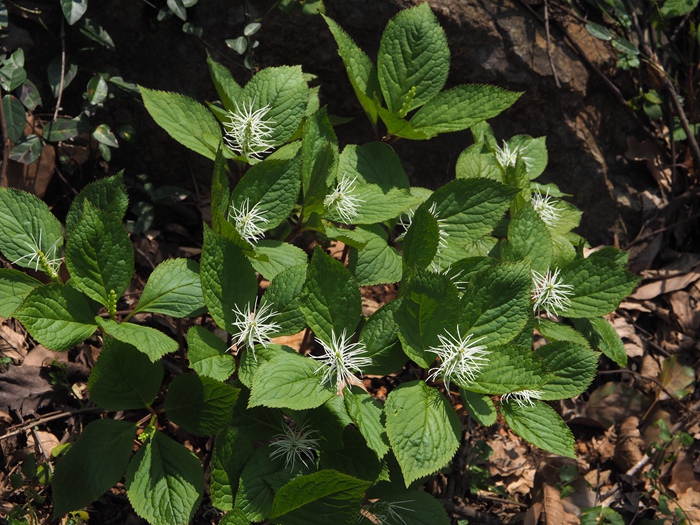- Scientific Name: Chloranthus fortunei (A.Gray) Solms
- Ref: A.P.de Candolle, Prodr. 16(1):476. 1869
- Synonyms: Chloranthus koreanus Nakai; Tricercandra fortunei A.Gray
- Chinese Common Name: 丝穗金粟兰 sīsuì jīnsù∙lán, 水晶花 shuǐjīng∙huā, 四大金刚 sì∙dà∙jīngāng
- Japanese Common Name: キビヒトリシズカ [吉備一人静] kibihitorishizuka
- Family: Chloranthaceae
- Genus: Chloranthus
- Distribution: Thickets, slopes, wet places, meadows, roadsides; 200-300 m. Anhui, Guangdong, Guangxi, Hainan, Hubei, Hunan, Jiangsu, Jiangxi, Shandong, Sichuan, Taiwan, Yunnan, Zhejiang
- Photo: 03/26/2017, Hangzhou, Zhejiang
Herbs perennial, 15-40 cm high, glabrous. Rhizomes thick, short, with many slender, long, fibrous roots. Stems erect, 1 or several in a fascicle, basal nodes with 1 pair of scalelike leaves. Scalelike leaves opposite, triangular. Leaves opposite, usually 4 in apical part of stem; stipules laciniate becoming subulate; petiole 1-1.5 cm; leaf blade broadly elliptic, long elliptic, or obovate, 5-11 × 3-7 cm, papery, glandular mucronate, sub-basal part entire, densely finely glandular abaxially when young, glands inconspicuous when old, base broadly cuneate, margin crenate-serrate or coarsely serrate, apex acute; lateral veins 4-6 pairs; reticulate veins conspicuous. Spike solitary, arising from stem apex, 4-6 cm with peduncle; bracts obovate, usually 2- or 3-toothed. Flowers white, fragrant. Stamens 3; connectives elongated, linear, erect or ascending, 1-1.9 cm, connate at base, on outside of apical part of ovary; central connective with a 2-loculed anther; lateral connectives with a 1-loculed anther each; thecae at base of connectives. Ovary obovoid; style absent. Drupes pale yellowish green, globose, striate, ca. 3 mm, subsessile. Fl. Apr-May, fr. May-Jun. 2n = 30, 60*. (Flora of China)
